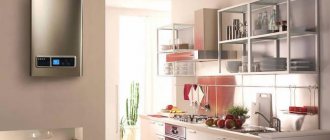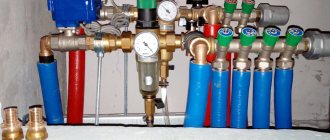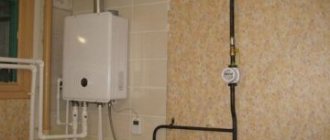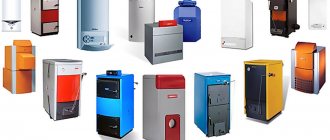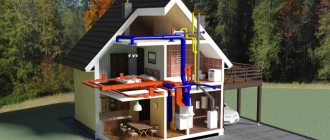It is recommended to heat the living room or dining room using infrared panels, which allow creating zones of increased thermal comfort.
According to the principle of operation, all electric heating devices can be divided into convection (radiators, convectors, fan heaters, underfloor heating systems) and radiant (various models of infrared heaters).
- When the first ones operate, warm air rises to the ceiling and displaces cold air from there, which, in turn, is sent down. Thus, the process of convection occurs.
- Electric heating devices of the second type operate on the principle of sunlight. Thermal radiation from a device hanging under the ceiling or on the wall is transmitted to the floor, furniture, and the human body, which heat up as if from sunlight, and at the same time they themselves begin to give off heat to the air.
Some experts also classify electric boilers as electric heating devices.
True, the PETN spirals of such devices heat water, not air. But since the latter is used, in particular, for heating a home, it seems that the boiler can rightfully be classified as electrical equipment. Below we will look at the features of various types of electric heating devices, and then we will try to determine which of them will be appropriate in an apartment, and which will be suitable for a small country house, cottage, etc. expert opinion Dmitry
Shabanov, senior manager of the sales department of the Engineering Systems Agency
Quite often, owners of apartments and country cottages purchase infrared heaters for their “possessions.” However, it must be taken into account that a person exposed to the rays of such a device for a long time will most likely not feel very comfortable. It's like spending the whole day in the sun, except you won't get a tan. Therefore, I do not recommend installing infrared panels in the living room or, say, in the bedroom above the bed.
It is much more reasonable to place them in “passage” places: the living room, on the veranda, etc. However, one should not think that long-wave infrared radiation is harmful to the human body. After all, many have probably heard about the benefits of therapeutic procedures in infrared cabins. This therapy helps fight colds and cellulite. So there is no need to be afraid of infrared heaters. The main thing is to observe moderation (you can, for example, choose a low-power device).
Mikhail Danilov Director of Marketing and Sales of JSC Elektroscandia
In city apartments, central heating usually combats the cold. Therefore, the use of electric heating devices can only be recommended as a supporting, safety option (for example, during off-season periods when hot water may be turned off). As such an alternative, I would advise choosing an oil radiator or convector. But “warm floors” are advisable if the room has a tiled or stone floor. In my opinion, it is not advisable to heat wooden floors (for example, parquet).
How and what type of electric heater to choose for an apartment or house
If your apartment has central, autonomous heating or gas, stove, etc. heating in a private house copes with its task 100%, then this article may interest you only as a means to “broaden your horizons.” But if you are faced with acute questions about the need to use an additional heat source in the cold season, and how to choose a heater, then I hope this article will be really useful.
There are quite a few types of electric household heaters - from the simplest, used everywhere, to the “exotic”. They differ in the “type” of heat source, heating principle, power consumption, design, dimensions, price, etc. Therefore, the article will consider only the main types of electric heaters, which are most often used by the “average” person, have a “reasonable” cost and can be used in a household electrical network. The pros and cons for each of the considered types of electric heaters will also be noted.
Fan heaters
The heating element (most often a conventional open coil, but a tubular or ceramic heating element can also be used) increases the temperature of the air in close proximity to the heating element. Then the heated air is distributed throughout the room using a fan that blows on the heating element. Thus, in the forced convection mode, with the help of a fan, already heated, warm air is removed from the heating element and cold air is supplied to the heating element for subsequent heating.
The average heater power is 1500-2000 W. The average heating area is 12-25 square meters.
- rapid heating of indoor air due to forced convection
- uniform heating of the air in the room due to forced convection
- low cost
- small weight and dimensions
- mobility
- high noise level during operation
- decreased oxygen level in a heated room
- smell from dust particles “burning out” when they come into contact with an open heating element
Oil heaters
The heating element, located inside the sealed heater housing, which is filled with coolant (most often mineral oil), heats the coolant. The hot coolant circulates inside the sealed metal housing, heating the housing itself. The heated metal casing transfers heat to the air located in close proximity to the walls of the radiator. Warm air spreads through the heated room by natural convection.
The average heater power is 2000-2500 W. The average heating area is 20-25 square meters.
- absence of noise during operation (except for periodic clicks of the automation relay)
- does not reduce the oxygen level in the heated room
- no unpleasant odor during operation
- relative economy
- slow heating of the air in the room
- uneven heating of the air in the room
- relatively large dimensions
- large mass
Convectors (convection heaters)
There is a heating element inside the metal tube of the convector. The “supply” of cold air to the heating element and the outflow of heated air occurs in natural convection mode. Those. heated air rises, displacing cooler air. Cold air falls down, from where it is naturally directed to the convector for heating. Convectors can be either floor-mounted (installed on legs with wheels) or wall-mounted (directly rigidly mounted on the wall of the room).
Water system
The most commonly used and therefore have the widest range of heating devices are water heating systems. This is explained by their good efficiency and optimal level of costs for acquisition, installation and maintenance.
Structurally, the devices are not too different from each other. Inside each there are channels for the flow of hot water, the heat from which is transferred to the surface of the device, and then, using convection, to the air of the room. For this reason they are called convection.
The following types of radiators can be used in water heating systems:
- cast iron;
- steel;
- aluminum;
- bimetallic.
All of these heating devices have their own characteristics, due to which they are selected for each specific case depending on the area of the room, the nuances of installation, the quality and type of coolant (which is sometimes antifreeze).
The power of each device is regulated by the number of sections, which can be selected by almost anyone. Although, if the estimated length of one battery is more than 1.5–2 m, it is recommended to install two smaller devices next to each other.
Cast iron batteries
Cast iron was one of the most popular materials in domestic heating systems. His choice, as a rule, was due to the relatively low cost. Later, such devices began to be used less frequently, since they have a small heat transfer coefficient (only 40%), due to which the power of one section is approximately 130 W. Although they can still be found in old-style systems. In modern interiors, designer models of cast iron radiators are sometimes used.
The advantages of such devices are a large surface area that transfers heat to the room, and a long operating period (up to 50 years). Although there are still more disadvantages - these include the relatively large volume of coolant used (up to 1.4 liters), the difficulty of repair, and the inertia of heating, due to which the temperature of the device increases relatively slowly, and even the need for periodic (at least once every 3 year) cleaning. In addition, heavy sections are very difficult to install.
Aluminum radiators
The use of aluminum radiators allows us to ensure the maximum level of heat transfer - the power of the section can reach 200 W (which is enough to heat 1.5–2 sq. m).
Their cost is quite affordable, and their low weight allows you to install them yourself. True, the operation of the device is possible for only 20–25 years.
Bimetallic batteries
Their advantages include the presence in the design of convection panels that improve air circulation over the surface, ease of installation of devices for regulating the intensity of coolant flow, as well as ease of installation. The radiator section, with a power of up to 180 W, is capable of heating about 1.5 square meters. m area.
Despite the advantages that such heating devices have, there are also problems with their use. For example, for bimetallic radiators it is not recommended to dilute water with antifreeze, which, although they do not allow the system to freeze, negatively affects the internal surfaces of heating devices.
In addition, these options are the most expensive of all that are used in a water heating system.
Electric heating devices
Electric heating devices and systems are among the local and most mobile heating devices: they are capable of efficiently heating only small rooms, since their power is limited and this is their main drawback.
Electric heating devices are used for both primary and additional heating of premises. Electric heating devices differ according to the principle of operation, the cost of the equipment and the intended purpose, but in any case they help cope with the cold in a particular room.
- An example of the most famous electric heating devices can be:
- oil radiators,
- electric convectors,
- fan heaters,
- heat guns,
- infrared heaters,
- heated floors, etc.
Varieties
Most often, the classification of heating devices is carried out according to the following criteria:
- the coolant used, which can be heated water, gas or even air;
- material of manufacture;
- operational characteristics: size, power, installation method and the ability to regulate the heating rate.
It is better to select the optimal option, taking into account the characteristics of the building’s heating system, operating conditions, observing all the requirements for heating devices.
In addition to the performance of devices, it is worth considering the possibility of their installation. For example, in the absence of gas supply and the impossibility of organizing water heating, the only option will be electrical appliances.
What is an electric infrared heater
Electric infrared heaters began to be actively used as heating devices not so long ago. Their operating principle is based on the use of infrared radiation energy. Most people successfully use them as an additional source of heating for private houses, dachas, and apartments, although nothing prevents them from becoming their main heating devices. Electric infrared heaters, unlike conventional convectors, heat the surrounding objects rather than the air, which contributes to more uniform heating of the room. Thanks to their unusual operating principle, infrared heaters can heat not only indoor spaces, but also open areas. They are used to heat outdoor cafes, gazebos, and playgrounds. According to experts, infrared heaters are an effective, durable and reliable means of heating.
Advantages and disadvantages of using electricity for heating purposes
It should be noted right away that using electric heaters for heating is not the cheapest option, since the cost of the equipment itself, as well as operating costs, are too high. Therefore, it is most often considered as an alternative, in case of interruptions in the gas supply or, if there is no gasification at all. At the same time, heating a house using electrical appliances has some obvious advantages:
- Almost universal availability.
- Very fast and easy installation.
- Convenient controls.
- Compact device design.
- Complete absence of any combustion products.
Thus, despite all their shortcomings, associated mainly with the economic component of the issue, electrical appliances have a lot of useful qualities that heating devices based on fuel combustion cannot boast of.
What is an electric fireplace (electric fireplace)
An electric fireplace is a heating device with the visual effect of a burning fire, therefore it is often used as interior decoration. It is used in city apartments and houses as an alternative to the classic wood or coal fireplace. An electric fireplace consists of two elements – a heater and a visualization screen. A spiral, heating element or infrared emitter with a power of up to 2 kW are used as the heating part. And artificial flames, special lighting and sound effects create the illusion of the flames of burning wood.
What is an electric oil cooler
The operating principle of an electric oil radiator is simple - an electric spiral heats the mineral oil, and it transfers heat to the metal body. Oil radiators can be flat or resemble a multi-section battery, in which individual segments and heating elements are hermetically connected to each other and form a common monolithic body. An electric oil radiator is a compact, simple and easy-to-use heating device.
What is electric heated floor
Electric floors are a floor-mounted system of cables, wires and heating film for heating a room, allowing you to keep rooms, loggias, toilets and bathrooms warm. An electric floor can exist either as a stand-alone or as an additional heating system. This scheme works well on any type of floor and can be installed in houses made of any material.

